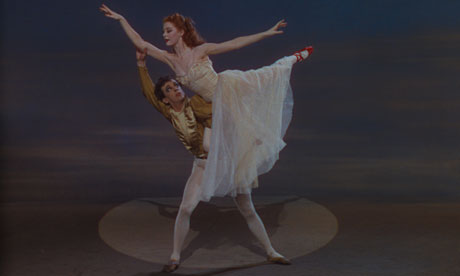
I remember the first time I watched The Red Shoes. I was a child, it was on the television some rainy afternoon, and I watched it on my own. I think I was probably expecting a straightforward retelling of Hans Christian Andersen's fairytale, also called The Red Shoes – though why that would be reassuring viewing I don't know, since Andersen's story, like his disturbing tale The Little Mermaid, is a thoroughly disquieting piece of work.
Instead, this film – which I would later discover was made in 1948, by Michael Powell and Emeric Pressburger – was set in postwar London, with an aspiring ballerina at its heart, played by the luminous, flame-haired Moira Shearer. The Red Shoes of the title is the name of the ballet that is created for Shearer's character, Victoria Page. And one of the overwhelming triumphs of the film is the utterly original vision of that ballet, which we see at the centre of the film. Abandoning realism, this virtuoso passage, deeply influenced by mid-century surrealism, imagines the ballet as if projected direct from Page's subconscious. I was terrified.
When I rediscovered the film in my 30s, that central section had lost none of its power to disturb. If anything, I now find it more shocking than I did on that memorable first viewing: those red shoes, I now realise, are absolutely dripping with dark imagery about female sexuality (menstruation, loss of virginity) and creativity. But what draws me to the film, and moves me so much, is that it is an artwork about art. And it is not only about the intensity, excitement, camaraderie and brutal discipline involved in making art, but also about the act of loving it.
I find that I am lost to the film, every single time I see it, by the end of the opening sequence, in which a group of students burst through the entrance to the "gods" in the Royal Opera House then race up the stairs as if their very lives depended on it. They start to watch the ballet that unfolds before them with the kind of greed with which a condemned man might eat his last meal. It makes me cry, reliably, every time I see it, and I find I'm hard pressed to explain exactly why, except that it must chime profoundly with my own inarticulable feelings about the art I love.
The look of the film, especially in its glorious recent restoration, is compelling. For a start, the colours: the red ballet shoes, of course, but also Moira Shearer's fireburst of copper hair, her topaz-coloured ballgown as she ascends the steps of a crumbling south-of-France villa, a flash of delphiniums as they are conveyed across Covent Garden market. I love the vision of a half-destroyed yet intellectually alive postwar London that it conjures – a city in rubble and yet full of possibilities.
Individual scenes, too, loom large in the memory: the melodramatic passage in which the Svengali-like ballet company director, Boris Lermontov (Anton Walbrook) paces his Parisian boudoir and smashes his rococo mirror in rage. Or, by contrast, the delightful section in which the company of dancers celebrates a birthday amid the balmy evening breezes of the Côte d'Azur. For if I have made the film sound grim, that is doing it a disservice – one of its achievements is its apparently wilful, but I suspect very carefully calibrated, tonal shifts, which see it moving from light-footed comedy to darkness in the blink of an eye (a quality it shares with other Powell and Pressburger films, including my colleague Xan Brooks's favourite film, A Canterbury Tale).
But what for me is breathtaking about the central ballet section it is its attempt to capture the "out-of-body", fugitive experience of an artist in performance, when the conscious mind is suppressed and the body and pure instinct take over. It makes us, the viewer, not merely see Victoria but become her. The passage is, in all kinds of ways, profoundly unsettling: the way it deploys scraps of visual imagery from the rest of the film is exactly like the way one sees detritus from one's waking life subtly and sometimes frighteningly distorted in dreams.
At the same time, of course, the ballet The Red Shoes, aside from being a fairytale about a pair of enchanted shoes, is a metaphor for the way Victoria becomes utterly possessed by her single-minded pursuit of art. And it is a story that, grimly, ends in destruction, for the red shoes cannot be taken off, but dance their wearer to death. It is a film that plumbs the dark recesses of all our imaginations: dangerous, glorious, absurd, vivid and terrifying by turns.

